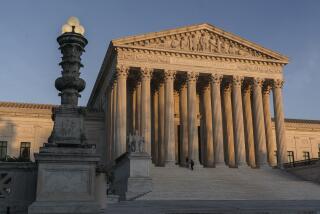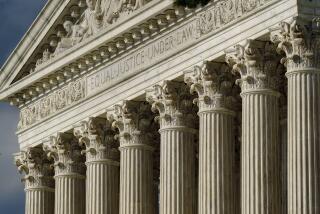Justice, Brennan Style
In 1819, in the case of McCulloch vs. Maryland, Chief Justice John Marshall proclaimed, “It is a constitution we are expounding,” and the italics are Marshall’s. He meant that the document on which American democracy is based provides a broad framework for government flexible enough to leave specific decisions to Congress and the courts.
Since then, constitutional scholars and commentators have conducted a lively debate about what the Constitution means. Must judges be bound by the intentions of the framers, as best they can be gleaned, or are they free to reinterpret the Constitution to meet changing needs?
The Reagan Administration is the foremost proponent today of the idea that judges should hew to what the framers of the Constitution intended. Last summer, Atty. Gen. Edwin Meese III lambasted the Supreme Court for failing to follow “the original meaning of constitutional provisions.” He said the court’s decisions upholding the strict separation of church and state “would have struck the founding generation as somewhat bizarre.”
But Meese now has a forceful and distinguished opponent--Associate Justice William J. Brennan Jr., who over the weekend told an audience at Georgetown University in Washington:
“Those who would restrict claims of right to the values of 1789 specifically articulated in the Constitution turn a blind eye to social progress. . . . We current Justices read the Constitution in the only way we can: as 20th-Century Americans. We look to the history of the time of framing and to the intervening history of interpretation. But the ultimate question must be, what do the words of the text mean in our time?”
In his speech last summer, Meese accused the court’s majority of substituting their own political views for judicial ones. In his response on Saturday, Brennan, who is the court’s most senior and most liberal justice, said that insistence on harking to the framers’ intentions masked a political judgment in its own right.
“This is a choice no less political than any other,” Brennan said. “It expresses antipathy to claims of the minority to rights against the majority.”
On the strictly constitutional question, there can be no doubt that Brennan is right, and Meese is wrong. The 14th Amendment, for example, is the part of the Constitution that is interpreted today as a rock-hard guarantee of racial equality. No one, not even Meese, disputes that. Yet the galleries of the Congress that adopted the 14th Amendment after the Civil War were racially segregated.
The framers of that amendment obviously weren’t thinking about racial segregation. Does that mean it may not be used to strike down discrimination today? Of course not.
It is highly unusual and not without risk for judges--much less Supreme Court justices--to get into a political debate. But Brennan’s integrity and propriety are unquestioned, and what he said needed saying. He argued that the enduring part of the Constitution is its overarching principle of “human dignity,” and that is what the justices apply.
“The genius of the Constitution,” Brennan said, “rests not in any static meaning it might have had in a world that is dead and gone, but in the adaptability of its great principles to cope with current problems and current needs.”
Or, as John Marshall said in 1819, “It is a constitution we are expounding.”
More to Read
Get the L.A. Times Politics newsletter
Deeply reported insights into legislation, politics and policy from Sacramento, Washington and beyond. In your inbox three times per week.
You may occasionally receive promotional content from the Los Angeles Times.










